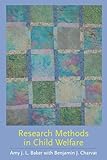Research Methods in Child Welfare / Benjamin Charvat, Amy J. L. Baker.
Material type: TextPublisher: New York, NY : Columbia University Press, [2008]Copyright date: ©2008Description: 1 online resource (464 p.) : 3 halftones, 0 color illus., 40 line drawings, 25 tablesContent type:
TextPublisher: New York, NY : Columbia University Press, [2008]Copyright date: ©2008Description: 1 online resource (464 p.) : 3 halftones, 0 color illus., 40 line drawings, 25 tablesContent type: - 9780231141314
- 9780231512145
- 362.7072 22
- HV741 .B294 2008
- online - DeGruyter
- Issued also in print.
| Item type | Current library | Call number | URL | Status | Notes | Barcode | |
|---|---|---|---|---|---|---|---|
 eBook
eBook
|
Biblioteca "Angelicum" Pont. Univ. S.Tommaso d'Aquino Nuvola online | online - DeGruyter (Browse shelf(Opens below)) | Online access | Not for loan (Accesso limitato) | Accesso per gli utenti autorizzati / Access for authorized users | (dgr)9780231512145 |
Frontmatter -- Contents -- Figures -- Tables -- Foreword -- Acknowledgments -- [1] Introduction to Child Welfare Research -- [PART 1] Planning and Developing Research Studies -- [2]. The Philosophy and Logic of Research -- [3] Ethical Considerations -- [4] Problem Formulation -- [5] Sampling Theory -- [PART 2] Design Strategies -- [6] Single- System Design -- [7] Group Designs -- [8] Using Existing Data -- [PART 3] Measurement Strategies -- [9] Measurement Theory and Measure Selection -- [10] Surveys -- [11] Case Studies -- [12] Focus Groups -- [13] In- Depth Interviews -- [PART 4] Data Analysis and Writing Up and Sharing Research Results -- [14] Data Analysis Techniques -- [15] Dissemination of Research Findings -- [PART 5] Special Topics in Agency Practice -- [16] Continuous Quality Improvement in Agency Practice -- [17] Agency- Based Program Evaluation -- [18] Final Thoughts -- Classroom Discussion and Activity -- Glossary 1: Social Science Research Methods Terms -- Glossary 2: Child Welfare Practice and Policy Terms -- References -- Index
restricted access online access with authorization star
http://purl.org/coar/access_right/c_16ec
Social service agencies are facing the same expectations in quality management and outcomes as private companies, compelling staff members and researchers to provide and interpret valid and useful research to stakeholders at all levels in the field. Child welfare agencies are particularly scrutinized. In this textbook, two highly experienced researchers offer the best techniques for conducting sound research in the field. Covering not only the methodological challenges but also the real-life constraints of research in child welfare settings, Amy J. L. Baker and Benjamin J. Charvat present a volume that can be used both for general research methods and as a practical guide for conducting research in the field of child welfare. Baker and Charvat devote an entire chapter to ethical issues involved in researching children and their families and the limits of confidentiality within this population. They weave a discussion of ethics throughout the book, and each chapter begins with a scenario that presents a question or problem to work through, enabling readers to fully grasp the methods in the context of a specific setting or area of concern. Special sections concentrate on the value of continuous quality-improvement activities, which enable the collection and analysis of data outside of the strictures of publishable research, and the implementation of program evaluations, which can be helpful in obtaining further research and programmatic funding.
Issued also in print.
Mode of access: Internet via World Wide Web.
In English.
Description based on online resource; title from PDF title page (publisher's Web site, viewed 02. Mrz 2022)


